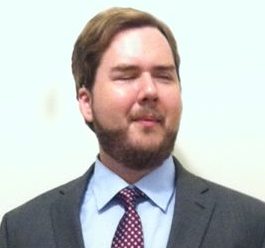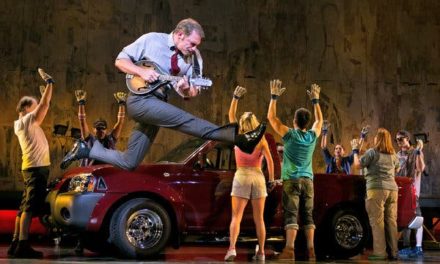New Louisville Orchestra Musical Director Teddy Abrams.
Photo-Sam English
Fanfara
Louisville Orchestra
Teddy Abrams, conductor
Review by Chris K. Stewart
Entire contents copyright © 2014 by Chris K. Stewart. All rights reserved.
The Louisville Orchestra opened its 77th season on Saturday night and welcomed new Music Director Teddy Abrams to Louisville. The orchestra and its leadership presented a performance and atmosphere that can only be described as special. Unlike most symphony concerts, the excitement was enhanced – not tempered – by the introductory remarks, and the audience was not fidgeting and anxiously awaiting the downbeat while politely applauding the obligatory recitation of sponsors and orchestra news. Rather, three influential Louisvillians primed patrons for a symphonic journey.
Mayor Greg Fischer, Lieutenant Governor Jerry Abramson, and president of the LO’s board of directors Jim Welch welcomed the audience and far surpassed the standard pre-concert pleasantries common at such events. Mayor Fischer spoke candidly, noting that the orchestra is currently on course for a great future, but recent difficulties could have spelled a very different result for the LO. Lieutenant Governor Abramson spoke of the orchestra’s import to the community and the Commonwealth. Mr. Welch, however, offered the most exciting comments when he stated that, as the president of the board of directors, he considered it his duty to help the LO serve as a representation nationally of exactly what an orchestra should be in the 21st century. Moreover, Mr. Welch stated that it will be the mission of the LO to reach every corner of Louisville. Hopefully, this means a ramping up of educational and outreach programs for disadvantaged children and other underserved members of the community. The ovation that followed Mr. Welch’s comments was prolonged and sincere.
No one is more surprised than I to have dedicated a portion of my review to the opening remarks, but much of what was said bears repeating and is hopefully indicative of a new frontier for the LO.
Before commenting on the performance itself, I would like to put last night in perspective. Every citizen of Louisville should take a moment and appreciate that the LO has been performing for 77 years this season. Not only is this an outstanding tenure for its length, but also the circumstance of the orchestra’s creation is really quite extraordinary. Conductor Robert Whitney and then Louisville mayor Charles Farnsley collaborated in 1937 to realize the dream of providing a musical heartbeat to Louisville. Without question, forming such an ambitious ensemble in the midst of the Great Depression is nothing short of amazing. Ten short years after its creation, the LO became the first American orchestra to own its own recording label and established itself as one of the premier orchestras for the recording of new American music. Despite recent struggles over financial concerns and labor issues, the LO is performing and stronger than ever.
Immediately following the opening remarks, new Music Director Teddy Abrams took the stage and conducted the orchestra in a performance of “The Star Spangled Banner,” which the entire audience joined, singing with bravado and, somewhat surprisingly, nearly flawless intonation.
With the next piece, it became apparent that Louisvillians have a new “Teddy” to cheer for. The first piece was Abrams’ own Overture in Sonata Form, which he composed as a musical gift to the orchestra. Immediately, the audience knew they would not need to struggle to understand a post-modern work of academia written more for music faculty than music fans. Instead, my first impression, meant with nothing but respect and stated with tongue firmly in cheek, was that Stravinsky had been hired as the arranger for Tower of Power.
Abrams exhibited excellent use of the sonata form. Put simply, pieces in sonata form begin with a main theme: called the exposition. Then, the composer develops this theme. The development may consist of elaborate re-orchestrations of main ideas, key changes, complex counterpoints, or in Abrams’ case, all of the above. Finally, the main theme is presented again, sometimes in an even more exuberant styling than in the beginning. This final section is the recapitulation. While not used all that prevalently in modern composition, the sonata form is the foundational form of western music, and whether listeners are aware of the form or not, it typically packs the biggest musical punch because of its accessibility and familiarity.
Abrams is clearly a lover of American popular music. The opening theme centered on a modified A major blues scale. A drum set swung the orchestra into the season, and a pianist hammered out rock & roll riffs that fit seamlessly into Abrams’ musical landscape. The brilliance of the piece, however, lies in the manner in which the composer flawlessly wove these elements into a modernistic composition that was both original and accessible. Parts of the piece sounded minimalistic. In fact, a recurring theme of six or seven notes passed through the orchestra, most prominently featured by the clarinet.
During the development section, Abrams used flowing and highly technical string runs to invoke images of an ocean. As an audience member, I wondered if he was attempting to reflect the tumult of societal evolution in his own thematic development. Finally, the trumpets triumphantly restated the main theme. The drum set kicked back into life, and the recapitulation brought the audience back to earth.
Immediately following this demanding performance, a winded Teddy Abrams addressed the audience. I do not think it is overly bold for me to predict that the Louisville Orchestra is clearly preparing to take a significant step forward, and Mr. Abrams is exactly the catalyst needed to facilitate this evolution. His energy is nothing short of incredible. His belief that the orchestra can be the musical soul of a community was clearly sincere, and the certainty and eloquence with which he expressed this view left me not just wanting to know more about him, but excited to start a new musical adventure with Abrams at the helm.
Finally, the orchestra performed Gustav Mahler’s Symphony No. 1 in D Major, “Titan.” The history of Mahler’s first symphony is as complex and mysterious as the music itself. In its 1889 premier, the piece was titled Symphonic Poem in Two Sections. Notably, this version featured an andante section between the modern day first and second movements, which Mahler later removed. Mahler continued making major revisions following the original work’s poor reception until the first publication of the score ten years later in 1899. The published form generally lasts around 55 minutes, making it one of Mahler’s shorter symphonies.
The Louisville Orchestra sounded as good as I have ever heard them, and I would have proudly taken any out of town guest to hear them on Saturday. The first movement is very restrained throughout. The music, however, is deceptively difficult and contains many potential orchestral stumbling blocks. Motifs are frequently passed from section to section with every opportunity for slips in intonation or metric dragging. The musicians were, however, on point. With the exception of one instance where a clarinetist entered particularly flat, the orchestra’s intonation was immaculate. The clarinetist quickly rectified the situation and sounded fantastic for the remainder of the performance.
I could write about Mahler’s use of themes from his own previous works and his brilliant interweaving of musical allusions to Wagner and other great composers, but many musicologists have already done so much more ably than I can. Instead, I will focus on the orchestra. The LO only grew stronger as the symphony progressed, an impressive feat considering the length and complexity of the work. The second movement is a scherzo in ¾ time. The third contains a funeral march. The main theme of the march is introduced as a round by the brass and is a minor version of the folk song “Frere Jacques” or “Are You Sleeping.”
Finally, the fourth movement references themes from throughout the symphony, and the brass section is called to dig deep one more time and blast the audience with a powerful wall of sonorous chords and soring melodies. Whether inspired by Teddy Abrams’ direction, the start of a new season, or simply the brass players’ love of Mahler, the horns created a triumphant ocean of sound, perfectly matching the call of the late romantic era music.
At the risk of coming across as a gushing critic, I will leave it there, but I cannot suggest any more strongly that anyone with an interest in orchestral music check out the remainder of the LO’s season. The women and men of the Louisville Orchestra are among the most talented individuals in the state of Kentucky. Now, with the energy, vision, and conducting prowess of Teddy Abrams driving the orchestra’s progress, I am as excited as I have been in many years to get back to Whitney Hall and hear the Louisville Orchestra again.
Fanfara
September 6, 2014
Louisville Orchestra
Kentucky Center for the Arts
501 West Broadway
Louisville, KY 40202
Louisvilleorchestra.org
 [box_light]Chris K. Stewart is a Kentucky native who graduated with a music performance degree from the California Institute for the Arts. He worked in Southern California as a professional violinist before deciding to move home and marry his best friend. Now, he is a law student at UK but can still be seen playing fiddle around the Louisville area. He began writing for Arts-Louisville in 2013 and finds music writing a welcome break from legal scholarship. Follow him on twitter at @KyBlindJustice[/box_light]
[box_light]Chris K. Stewart is a Kentucky native who graduated with a music performance degree from the California Institute for the Arts. He worked in Southern California as a professional violinist before deciding to move home and marry his best friend. Now, he is a law student at UK but can still be seen playing fiddle around the Louisville area. He began writing for Arts-Louisville in 2013 and finds music writing a welcome break from legal scholarship. Follow him on twitter at @KyBlindJustice[/box_light]




